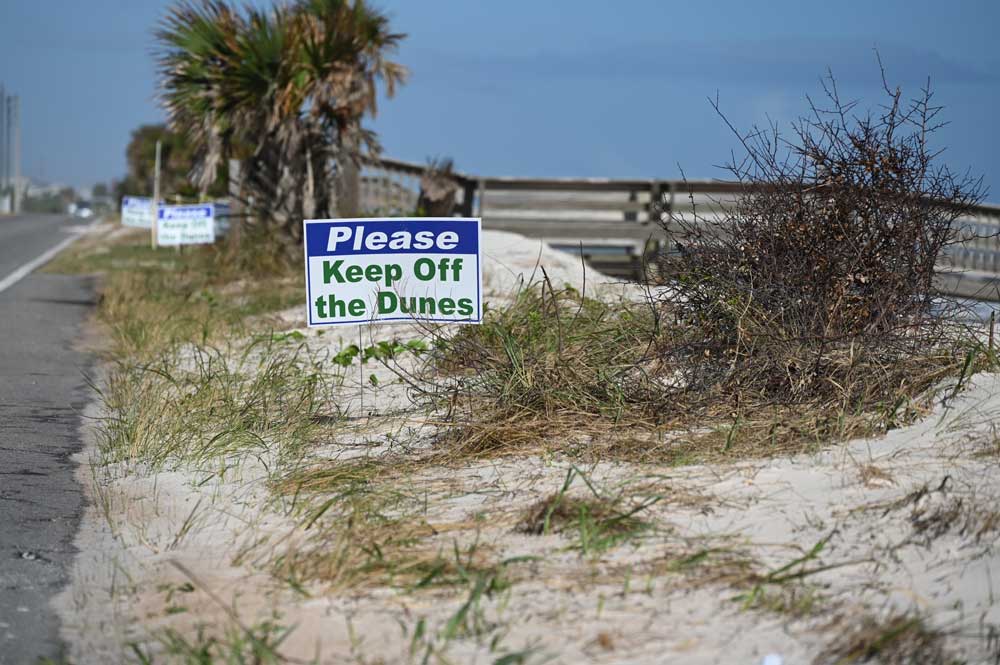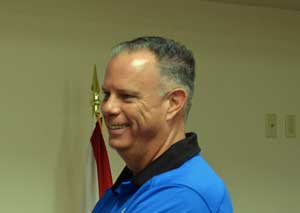
The Flagler County Commission on Monday is expected to approve an emergency order that criminalizes walking on dunes anywhere along the county’s 18 miles of shoreline. The penalty may be a $500 fine and 60 days in jail.
The order reflects several pulses of urgency: It is is prompted by an ongoing effort to maintain rebuilt dunes in the north of the county and a large-scale project starting in weeks that will rebuild dunes and the beach from North 7th Street in Flagler Beach down to the northern border of Gamble Rogers State Recreation Area. It is also an effort by the county to educate the public about the fragility of a dune system essential to the protection of land and property behind it, to the health of the beach, and to aesthetics that make Flagler County’s shore appealing.
Though most people don’t see it that way for lack of information or understanding, dunes are mini-ecosystems almost as fragile as coral, but above ground. “The materials of the beach are themselves steeped in antiquity,” once wrote Rachel Carson, the author of Silent Spring. “Sand is a substance that is beautiful, mysterious, and infinitely variable; each grain on a beach is the result of processes that go back into the shadowy beginnings of life, or of the earth itself.”

Flagler Beach has had a similar ordinance in place for years. But in Police Chief Matt Doughney’s recollection, no one has ever been criminally charged in a decade despite the city’s wealth of dunes, residents and visitors. The reason, Doughney said: sustained education. The city has implemented a “Dodge the Dunes” campaign through the Tourist Development Council and other educational approaches that have made arrests unnecessary.
“Compliance is the goal,” Doughney said, “and if you can educate somebody that’s not from here, once you educate them and they comply with what you want them to do, I think that’s paramount to being successful. So if you educate them and you don’t have repeat offenders, isn’t that what we should strive for?”
County Attorney Al Hadeed acknowledges Flagler Beach’s success. “Flagler beach has done an excellent job of keeping people off the dunes,” he said. “The tradition of not damaging the dunes is well established in Flagler Beach.” In the northern part of the county, “it’s a whole different situation, it’s a more rural beach.” And it can sometimes make dune protection challenging when some of the county’s subdivisions at the north end, including Sea Colony and the frontier-like jumble of Rollins, Flagler, Atlantic and Moody Drive to the north that all sprawl all the way to the beach.
“It is absolutely not a rule for the sake of a rule, it has a very significant foundation, and the law enforcement will be able to explain it, The signs we have put up have not worked,” Hadeed said.
The ordinance is not directed at Flagler Beach, though–redundancy aside–it can be invoked even there. Rather, it is directed at that northern portion, where more beach-goers walk on the dunes, engage in activities and “damaging them very significantly, weakening what we’ve spent mullions of dollars to perfect what we could.”
The county spent millions of dollars repairing dunes after Hurricanes Matthew and Irma in 2016 and 2017, dunes that eventually were eroded away, and again spent more millions–mostly underwritten by state dollars–to rebuild them. A joint federal and local project, funded with federal and state dollars, is about to dump upwards of a million cubic yards of sand south of North 7th Street.
County Commission Chair Andy Dance supports the approach. “From a health, safety and welfare standpoint, it’s been hard to regulate maintenance of the dune system,” Dance–who is also a landscape architect–said. “So this has been proposed as a way to be able to kind of combat that. We’ve seen the importance of the dune. Now let’s talk about the requirement to give the vegetation some time to establish an appropriate root system. Disturbing those things is the worst possible thing for the dunes.”
The prohibited area of a typical dune begins at its lowest point leeward from the crest to its lowest point seaward, where the vegetation line stops. near The order does not prohibit a property owner or a home owner association from using alternatives to walkovers, such as Mobi-mats, to access the beach.

Flagler Beach has protected its dunes in part because it has 52 public and private walkovers in the city. The county has many fewer, among them at five seaside county parks–Bay Drive Park, MalaCompra Road Park, 16th Road Park, also known as “Old Salt Park, Jungle Hut Road Park and Varn Park.
The county and, likely, the Sheriff’s Office, will look to Flagler Beach for its experience and advise on enforcement. “I appreciate Mr. Hadeed’s support of our education process here in Flagler Beach,” Doughney, the police chief, said. “This is a big project for the entire county and for Flagler Beach itself. A lot of our locals know about the dunes but there’s in my opinion a misperception what a sea dune looks like.” He said it’s not always the rolling dune people, especially visitors, imagine. Locally, its crest can often be parallel with the road, especially in areas where the shoreline is critically eroded. So education in person or through handouts and social media is key, Doughney said. “I think that’s what Mr. Hadeed was commending us for.”
When someone is found to be walking on a dune in Flagler Beach, typically the person is warned. It works, without repeat offenses. “I don’t think we’ve arrested anybody in the 10 plus years I’ve been here,” Doughney said. City police do write tickets for drivers who park on the dunes, however. That’s been more of an issue. But sea fencing installed over the last couple of years has very effectively protected the dunes.
“If this gets approved by Flagler County, I’ll be more than happy to reach out with the sheriff,” Doughney said, to share resources. “Education is the key.”
![]()




























GW says
I agree that you have to be an idiot to walkover the dunes, but wait for the shitstorm when someone is arrested.
We have lost our decency and moral compass in his country.
Bob Z. says
I have contacted the sheriff’s department several times about people walking, playing, setting up tents, and anything else you can think of on the dunes near Marineland such as the River to Sea Preserve and nothing has changed. When I see a patrol car they just drive through or park in the parking lot and never get out and look, which is not hard when there is a boardwalk. The same thing happens at the beach at Washington Oaks State Park. We notified the rangers and they said it is too hard to enforce so they rarely look for offenders. And when we nicely tell people most ignore us or tell us to mind our own business, I am not sure what the solution is but more signs might help.
Marek says
Oh , may ! It’s too hard !
Wow says
Do the hotels on the beach have information they can put in each room? I always saw people walking out of the hotels and straight over the dune to the beach. Most would probably not know it’s illegal.
dave says
I see it all the time, not from tourist but locals, people who live there. That’s the real problem no freaking respect for laws.
Angela says
Better late than never Flagler Beach. We should have built a community mindset of environmental care in all decisions. But this reflects how Flagler Beach does better using the police than building a mindset. Flagler Beach will celebrate its 100th years in 2025. Flagler Beach have had plenty of time to focus on blue zone practices but I have never heard any such topic in any meeting. I heard about making laws to police our community.
Linda Hagman says
Between South 9th and 11st street in Flagler Beach there exists a worn path on the dune between beach access points. Daily people traverse on the dune passing right by the dune warning signs. There is no enforcement on foot traffic in this area and occasionally the police catch parking violations. This is the reality.
Brian Ford says
OK. Let me just post what many people are probably thinking. Doesn’t the Flagler County Commission have something better or more important to do? Criminalizing behavior like walking or parking on the dunes is a waste of time and puts an undue burden on law enforcement. Creating this new ordinance will provide cover for citizens (sometimes referred to as ‘Karens’) who admonish or yell and scream at fellow beach goers (and their children and their pets).
Our current enforcement methods and penalties seem to work pretty well. If the county could continue or add additional funding to dune awareness and preservation efforts (signage and …).
I’ve appeared before the Flagler Beach City several times over the past 4 years to propose installing bollards (short telephone poles) at each of the dune cross overs to make sure vehicles don’t block access. You know that’s important if you’ve ever seen emergency responders struggle around parked cars to get some injured person off the beach. I proposed post and rope fencing along the road side to better define where the roadside ends and the dunes begin. That’s important because in some places vehicles (try to) park nose in to the dunes or double park creating a hazard where people walk into a roadway with vehicles driving by at 45 or 35, or even 25 mile per hour (with the driver and passengers looking at the waves). These vehicles trample the plants that we need to strengthen the dunes.
Every Commissioner I’ve brought this to is interested but their concern is funding. Maybe the Flagler County Commission could help fund these proposals?
Common Sense is not Common and You Can not Fix STUPID says
But it is totally okay for tourist companies to offer daily horseback riding that tramples the dunes and for turtle patrol to ride ATVs across the dunes. Makes perfect sense.
Adam Frank says
I’m not sure why an emergency order would be needed (for a State of Emergency since Hurricane Matthew) in addition to an ordnance against walking on the dunes, that is already in place.
This is just another example of governmental overreach.
Jan says
We have observed a number of kids/teens sliding, climbing, or playing on the dunes by Jungle Hut Park. Have nicely explained to them that the dunes are fragile and that the dunes help protect the beach (and the houses), and to please stay off them. It’s a repeating scenario.
Suggestion: My sister owns a place in Bethany Beach Delaware. They have dune fences that are effective, protect the dunes, and help them grow. I found this on AI:
“Dune fences play a crucial role in maintaining the health and stability of coastal dunes. They serve several purposes:
Preventing Foot Traffic: Dune fences block pedestrian foot traffic from walking on the dunes, which can harm the dune ecosystem and overall stability.
Sand Accumulation: The fences help trap windblown sand along their lines, contributing to dune growth in both width and height.
Sand Retention: By preventing sand drift and migration, dune fences aid in retaining existing sand on the dune.”
Bethany Beach uses a company called Aquatic Marine. According to their website (I am not affiliated with them, just an FYI):
“When correctly installed, these fences can raise the dune’s height by up to four feet and expand its width by three to ten feet over one to two years.”
I go there every year to visit my sister and can attest that the dune fences work.
Seems like something worth considering.
Shark says
They can’t even enforce the dog ordinance !!! Dogs off leash everywhere. As far as the dunes, all we have to do is wait until the hurricane season and there won’t be any !!!
Tony says
Who is going to do the enforcement. FSCO is too busy running radar on I95 !!!
The Sour Kraut says
Education, signs and fines all make sense, but 60 days in jail??? Maybe for habitual offenders, but for a tourist that is just ignorant of local laws and of fragile ecology? Nuts!
JimboXYZ says
The idiocy of this is astonishing. On one hand there are people in this world that are that stupid that something like this has to be created in 2024. On the other hand we have the dunes being damaged & eroded away for every storm that Mother Nature throws at it. The reasons to keep people off the dunes isn’t one of damage to the environment, Mother Nature does far more damage than anything that any individual human has ever done to the dunes.
Bryce says
The irony is that just a couple of miles south, in OBS, Volusia county workers blacked out the signs stating to keep off the dunes and continually remove native vegetation planted by locals in an attempt to to block renegade dune crossings. The garbage collection company subcontracted by the county also constantly runs over the dune vegetation to avoid walking a few steps. Didn’t realize Flagler was having the same issue, but sounds like they are at least recognizing it exists. Hopefully Flagler gets some control over the situation and then there will be something to put pressure on Volusia to follow suit.